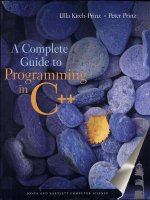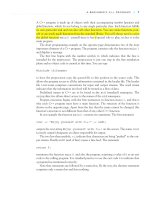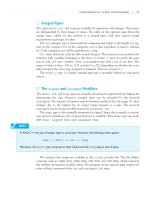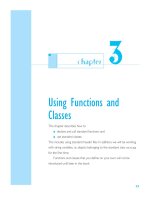A Complete Guide to Programming in C++ part 11 ppt
Bạn đang xem bản rút gọn của tài liệu. Xem và tải ngay bản đầy đủ của tài liệu tại đây (231.55 KB, 10 trang )
SOLUTIONS
■
79
cout << "Number of pieces: ";
cin >> count;
cout << "Price per piece: ";
cin >> price;
// Output:
cout <<
"\n\tArticle Number Quantity Price per piece ";
cout << "\n\t"
<< setw(8) << number
<< setw(16) << count
<< fixed << setprecision(2)
<< setw(16) << price << " Dollar" << endl;
return 0;
}
Exercise 4
#include <iostream>
#include <iomanip> // Manipulator setw()
using namespace std;
int main()
{
unsigned char c = 0;
unsigned int code = 0;
cout << "\nPlease enter a decimal character code: ";
cin >> code;
c = code; // Save for output
cout << "\nThe corresponding character: " << c << endl;
code = c; // Character code. Is only
// necessary, if input is > 255.
cout << "\nCharacter codes"
<< "\n decimal: " << setw(3) << dec << code
<< "\n octal: " << setw(3) << oct << code
<< "\n hexadecimal: " << setw(3) << hex << code
<< endl;
return 0;
}
80
■
CHAPTER 4 INPUT AND OUTPUT WITH STREAMS
When entering 336, the value 80 is stored in the low byte of variable code
(336 = 256 + 80).Thus after the assignment, the variable c contains the value
80, representing the character P.
Exercise 5
The corrected program:
// Corrections are commented.
//
#include <iostream>
#include <iomanip> // Manipulator setw()
#include <string> // Class string
using namespace std;
int main()
{
string word; // To read a word.
// char ch; is not needed.
// cout << instead of cin >> .
cout << "Let's go! Press the return key: ";
cin.get(); // Input newline character
cout << " Enter a word " // "
"containing three characters at the most: ";// "
cin >> setw(3) >> word; // setw(3) instead of
// setprecision(3)
cout << "Your input: " // <<
<< word << endl; // instead of >> ch
return 0;
}
81
Operators for
Fundamental Types
In this chapter, operators needed for calculations and selections are
introduced. Overloading and other operators, such as those needed for
bit manipulations, are introduced in later chapters.
chapter
5
82
■
CHAPTER 5 OPERATORS FOR FUNDAMENTAL TYPES
#include <iostream>
using namespace std;
int main()
{
double x, y;
cout << "\nEnter two floating-point values: ";
cin >> x >> y;
cout << "The average of the two numbers is: "
<< (x + y)/2.0 << endl;
return 0;
}
■
BINARY ARITHMETIC OPERATORS
Binary operator and operands
The binary arithmetic operators
Sample program
Sample output for the program
Enter two floating-point values: 4.75 12.3456
The average of the two numbers is: 8.5478
Operator
Left operand Right operand
a+b
+
-
*
/
%
Operator Significance
Addition
Subraction
Multiplication
Division
Remainder
BINARY ARITHMETIC OPERATORS
■
83
If a program is to be able to process the data input it receives, you must define the opera-
tions to be performed for that data. The operations being executed will depend on the
type of data — you could add, multiply, or compare numbers, for example. However, it
would make no sense at all to multiply strings.
The following sections introduce you to the most important operators that can be
used for arithmetic types. A distinction is made between unary and binary operators. A
unary operator has only one operand, whereas a binary operator has two.
ᮀ Binary Arithmetic Operators
Arithmetic operators are used to perform calculations. The opposite page shows an
overview. You should be aware of the following:
■ Divisions performed with integral operands will produce integral results; for exam-
ple, 7/2 computes to 3. If at least one of the operands is a floating-point number,
the result will also be a floating-point number; e.g., the division 7.0/2 produces
an exact result of 3.5.
■ Remainder division is only applicable to integral operands and returns the remain-
der of an integral division. For example, 7%2 computes to 1.
ᮀ Expressions
In its simplest form an expression consists of only one constant, one variable, or one
function call. Expressions can be used as the operands of operators to form more complex
expressions. An expression will generally tend to be a combination of operators and
operands.
Each expression that is not a void type returns a value. In the case of arithmetic
expressions, the operands define the type of the expression.
Examples: int a(4); double x(7.9);
a * 512 // Type int
1.0 + sin(x) // Type double
x – 3 // Type double, since one
// operand is of type double
An expression can be used as an operand in another expression.
Example: 2 + 7 * 3 // Adds 2 and 21
Normal mathematical rules (multiplication before addition) apply when evaluating an
expression, i.e. the *, /, % operators have higher precedence than + and In our exam-
ple, 7*3 is first calculated before adding 2. However, you can use parentheses to apply a
different precedence order.
Example: (2 + 7) * 3 // Multiplies 9 by 3.
84
■
CHAPTER 5 OPERATORS FOR FUNDAMENTAL TYPES
#include <iostream>
using namespace std;
int main()
{
int i(2), j(8);
cout << i++ << endl; // Output: 2
cout << i << endl; // Output: 3
cout << j << endl; // Output: 8
cout << j << endl; // Output: 6
return 0;
}
■
UNARY ARITHMETIC OPERATORS
The unary arithmetic operators
Precedence of arithmetic operators
Effects of prefix and postfix notation
+
-
++
Operator Significance
Unary sign operators
Increment operator
Decrement operator
Precedence Operator
Grouping
High
Low
++
++
+ -
*/
%
+
-
(postfix) left to right
left to right
left to right
right to left
(prefix)
(sign)
(addition)
(subtraction)
UNARY ARITHMETIC OPERATORS
■
85
There are four unary arithmetic operators: the sign operators + and -, the increment
operator ++, and the decrement operator
ᮀ Sign Operators
The sign operator – returns the value of the operand but inverts the sign.
Example: int n = –5; cout << -n; // Output: 5
The sign operator + performs no useful operation, simply returning the value of its
operand.
ᮀ Increment / Decrement Operators
The increment operator ++ modifies the operand by adding 1 to its value and cannot be
used with constants for this reason.
Given that i is a variable, both i++ (postfix notation) and ++i (prefix notation) raise
the value of i by 1. In both cases the operation i=i+1is performed.
However, prefix ++ and postfix ++ are two different operators. The difference
becomes apparent when you look at the value of the expression; ++i means that the
value of i has already been incremented by 1, whereas the expression i++ retains the
original value of i. This is an important difference if ++i or i++ forms part of a more
complex expression:
++i i is incremented first and the new value of i is then applied,
i++ the original value of i is applied before i is incremented.
The decrement operator modifies the operand by reducing the value of the
operand by 1. As the sample program opposite shows, prefix or postfix notation can be
used with
ᮀ Precedence
How is an expression with multiple operators evaluated?
Example: float val(5.0); cout << val++ – 7.0/2.0;
Operator precedence determines the order of evaluation, i.e. how operators and
operands are grouped. As you can see from the table opposite, ++ has the highest prece-
dence and / has a higher precedence than The example is evaluated as follows:
(val++) – (7.0/2.0). The result is 1.5, as val is incremented later.
If two operators have equal precedence, the expression will be evaluated as shown in
column three of the table.
Example: 3 * 5 % 2 is equivalent to (3 * 5) % 2
86
■
CHAPTER 5 OPERATORS FOR FUNDAMENTAL TYPES
// Demonstration of compound assignments
#include <iostream>
#include <iomanip>
using namespace std;
int main()
{
float x, y;
cout << "\n Please enter a starting value: ";
cin >> x;
cout << "\n Please enter the increment value: ";
cin >> y;
x += y;
cout << "\n And now multiplication! ";
cout << "\n Please enter a factor: ";
cin >> y;
x *= y;
cout << "\n Finally division.";
cout << "\n Please supply a divisor: ";
cin >> y;
x /= y;
cout << "\n And this is "
<< "your current lucky number: "
// without digits after
// the decimal point:
<< fixed << setprecision(0)
<< x << endl;
return 0;
}
■
ASSIGNMENTS
Sample program
ASSIGNMENTS
■
87
ᮀ Simple Assignments
A simple assignment uses the assignment operator = to assign the value of a variable to an
expression. In expressions of this type the variable must be placed on the left and the
assigned value on the right of the assignment operator.
Examples: z = 7.5;
y = z;
x = 2.0 + 4.2 * z;
The assignment operator has low precedence. In the case of the last example, the right
side of the expression is first evaluated and the result is assigned to the variable on the
left.
Each assignment is an expression in its own right, and its value is the value assigned.
Example: sin(x = 2.5);
In this assignment the number 2.5 is assigned to x and then passed to the function as an
argument.
Multiple assignments, which are always evaluated from right to left, are also possible.
Example: i = j = 9;
In this case the value 9 is first assigned to j and then to i.
ᮀ Compound Assignments
In addition to simple assignment operators there are also compound assignment opera-
tors that simultaneously perform an arithmetic operation and an assignment, for exam-
ple.
Examples. i += 3; is equivalent to i = i + 3;
i *= j + 2;
is equivalent to i = i * (j+2);
The second example shows that compound assignments are implicitly placed in paren-
theses, as is demonstrated by the fact that the precedence of the compound assignment is
just as low as that of the simple assignment.
Compound assignment operators can be composed from any binary arithmetic opera-
tor (and, as we will see later, with bit operators). The following compound operators are
thus available: +=, -=, *=, /=, and %=.
You can modify a variable when evaluating a complex expression by means of an
assignment or the ++, operators. This technique is referred to as a side effect. Avoid
use of side effects if possible, as they often lead to errors and can impair the readability of
your programs.
88
■
CHAPTER 5 OPERATORS FOR FUNDAMENTAL TYPES
■
RELATIONAL OPERATORS
The relational operators
Precedence of relational operators
Examples for comparisons:
Operator Significance
less than
less than or equal to
greater than
geater than or equal to
equal
unequal
<
>
<=
>=
==
!=
arithmetic operators
< <= > >=
== !=
assignment operators
Precedence Operator
High
Low
5 >= 6 false
true
false
true
1.7 < 1.8
4 + 2 == 5
2 * 4 != 7
Comparison Result









